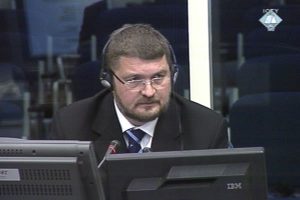Prosecution Expert Testifies About Srebrenica & Mass Graves
International Criminal Tribunal for Yugoslavia (ICTY)
Milosevic Trial – The Hague – Court Room One
Day 277, 26 January 2004

THE HAGUE – For more than five years, Prosecution Investigator Dean
Manning has been investigating mass graves and the bodies exhumed from
them in the area around Srebrenica, said to be the site of the worst
massacre of civilians since WWII. At one time or another, he has visited
every mass grave site, several at the time they were exhumed. Today, he
submitted his report to the Trial Chamber hearing the case against
Slobodan Milosevic, but cautioned that the investigation is still not
complete. Large numbers of body parts have not yet been identified.
Identified grave sites remain to be exhumed. And investigators anticipate
finding additional mass graves. [Dean Manning was one of the leaders
of the very small team of investigators working for the Office of the
Prosecutor. Their ‘investigation’ of mass graves was simply a matter of
liaison withthe ICMP (the US-run, Bosnian Muslim staffed body with formal
responsibility for such investigations), the United Nations and the various
western intelligence services. They did not carry out professional criminal
investigations of their own.]
individuals” (MMNI) which have been identified from the mass graves is
2,541. It is an “extraordinarily conservative” number, he testified. Serb
forces dug up bodies from primary burial sites and reburied them, using
heavy equipment which mangled and crushed the corpses, making
identification as well as establishing a firm number of bodies extremely
difficult. Mr. Manning said the estimated number killed at Srebrenica,
between 7500 and 8000, is based on the number identified as missing.
as those described in Srebrenica is a war crime, Milosevic nevertheless
questioned the numbers in Mr. Manning’s report. Alleging intense fighting
in the area between the Bosnian Army and VRS (Army of Republika Srpska),
the Accused asked how the investigator distinguished between bodies killed
in combat and those executed. The witness described finding bodies with
hands bound behind them and/or blindfolded. Investigators recovered 423
ligatures. Though bodies were decomposed and skeletal, some were clearly
shot in the head; others were found leaning in a forward position which
indicated they’d been shot in the back. Mr. Manning explained it was
likely the 1,440 bodies for which cause of death was not established were
also executed because of the way they were found lying among the other
bodies in the mass graves. [Several problems here also. First, the
the column of 15,000 men fleeing toward Tuzla. Mr. Manning testified that
the column may have included as many as 30,000 men and boys. Only the
forward part was armed and able to break through Serb lines, he said. The
middle and rear of the column were captured and transported to the killing
sites. There was no way to determine how many from the column were killed,
though he testified that a large number from both the column and the men
held at Potocari were executed. When asked how many men were captured, Mr.
Manning said an exact figure wasn’t available because “people who know it
were either killed or are captors not willing to provide it.” [Mr Manning’s
Bosnian Muslim men and boys were rounded up, from the column and Potocari,
and held captive. Survivors, witnesses and a few perpetrators have
testified that the captives were then transported to sites where they were
killed. The exhumations, investigation and identification of bodies are
ongoing. [Curiously the videotapes and telephone intercepts were merely
Manning about the ages of those killed. While most could be classified of
military age (between 17 and 55), the witness said there were also boys as
young as 9 and men in their 80’s and 90’s, as well as individuals who were
infirm. What the Accused and the Amicus are suggesting is that the vast majority
of bodies found in the mass graves near Srebrenica were men killed in
combat, as evidenced by their military age and the severity of fighting in
the region. Mr. Manning testified that forensic evidence (ligatures,
blindfolds, tied hands, position of bodies, etc.) contradicts this. The supposition
Submitted by Judith Armatta on 27 January, 2004 – Updated: 27 January 2004
15:05